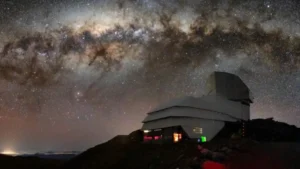Space is big. Vastly, hugely, mind-bogglingly big. And while that fact can be overwhelming if you’re planning to hitchhike to another planet, it does give the Webb Telescope a literally infinite variety of beautiful, enlightening images to show us.
The telescope’s latest snapshot from the cosmos depicts the birth of a star called L1527.
In the image, clouds of gas are drawn toward a central point (the neck of the hourglass shape), where they spiral down into a roughly spherical mass. The mass itself remains invisible in this image. And while the 100,000-year-old protostar isn’t dense enough for nuclear fusion quite yet, give it time.
As more and more dust and gas fall into the center of the mass, the core temperature will start to rise. Before you know it (cosmically speaking), fusion begins.

Webb Telescope images never get old. Photo: NASA, ESA, CSA, and STScI. Image processing: J. DePasquale, A. Pagan, and A. Koekemoer (STScI)
Normally hidden within its cloud in the Taurus star-forming region, this image of L1527 is only available to us because the Webb Telescope is specially designed to capture and interpret infrared light. The blue areas represent thin layers of dust, while the orange areas are where the dust is thickest.
The stringy features visible within the dust clouds are filaments of molecular hydrogen that L1527 flung out into space as a part of its formation. The turbulence this creates keeps new stars from forming in the dust cloud. L1527’s got this little corner of space all to itself.
Accretion disk
See that dark band in the very center of the hourglass’s neck? That’s called an accretion disk, and it’s about the size of our entire solar system. According to NASA, it’s pretty common for material in the accretion disk to clump together into planets.
Countdown to a new star ⏳
Hidden in the neck of this “hourglass” of light are the very beginnings of a new star — a protostar. The clouds of dust and gas within this region are only visible in infrared light, the wavelengths that Webb specializes in: https://t.co/DtazblATMW pic.twitter.com/aGEEBO9BB8
— NASA Webb Telescope (@NASAWebb) November 16, 2022
NASA says L1527 is a class 0 protostar — about as young as a protostar can get without just being a cloud. In fact, it’s only about 20 to 40 percent of the mass of our own local star.






